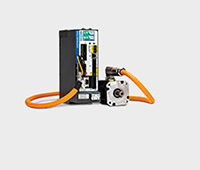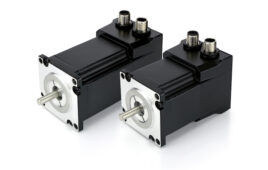Although medical devices like MRI, blood analysis machines and CT and PET scan equipment get most of the attention, they could not function without the custom covers, panels, housings, enclosures and other parts that give sensitive electronic components needed structure, protection, and aesthetics.
Custom medical device parts have long been made from thick-gauge thermoformed plastics. Recent advances in thermoforming technique and technology have increased the advantages of doing so.

A thermoformer with in-house trimming, routing, painting, screen printing, assembly, fabrication and fulfillment capabilities has more direct control over the entire process and can complete the job faster and at lower cost.
As a manufacturing process, thick-gauge thermoforming traditionally involves heating a 1/16 in. to 5/8 in. plastic sheet to a pliable forming temperature, shaping it in a mold, and then finishing it into a usable part. The result is a durable, anti-abrasion, lightweight, part with crisp features and fine surface detail.
With recent advances, medical device designers and manufacturers now have a range of new options, starting with a thick-gauge thermoforming capability of some vendors to create parts up to 9 ft by 13 ft, large enough for even the largest MRI covers.
Beyond this are choices ranging from built-in, anti-microbial agents to a twin-sheet thermoforming process that simultaneously thermoforms two sheets of plastic and bonds them together.
Oversize medical parts
MRI, PET, CT, and other medical equipment designed to image an entire human body can be massive. For large parts, the traditional approach has been to use molded fiberglass. However, fiberglass has size, wall thickness and radii limitations and is typically heavy.
Yet creating parts large enough to encompass the entire human body is unique to all but a few thermoformers because it requires a large capital investment. One company, which makes large covers for a majority of the MRI machines in the medical market, for instance, is capable of thermoforming parts up to 9 ft by 13 ft with a 60 in. draw.
Built-in anti-microbial protection
In health care, it is important to maintain a hygienic environment to restrict the spread of disease or contaminants. But that can be difficult with patients and personnel using medical devices, even with routine equipment cleaning.
One new option for medical device manufacturers is to add an anti-microbial agent during the manufacturing process that fights microbes such as bacteria, fungi, mold, and mildew. When the anti-microbial agent is spread throughout the thermoformed material, its protection is effective both on its surface and in its substrate, and will not wash or wear off.

A worker cuts an oversized piece of thick-guage thermoformed plastic, which is lighter, stronger and half the cost of fiberglass parts.
Twin-sheet thermoforming
For medical device parts, panels, or enclosures that will be seen from both sides, need added strength, or will house insulation, mechanical or electronic components, an advanced vacuum-forming technology called twin-sheet thermoforming is ideal. The process simultaneously thermoforms two sheets of plastic, then bonds them together to create a double-walled structure that is durable, lightweight, and economical.
Since twin-sheet thermoforming replaces two processes with one, it saves time and labor, and creates a seamless part and stronger structure.
On a recent redesign of enclosures for a medical diagnostic testing instrument, twin-sheet thermoforming reduced the cost of the doors by 30% to 50%, compared to a fiber reinforced plastics (FRP) process.
Compared to injection molding or blow molding, twin-sheet thermoforming can reduce tooling costs by up to 90% and cut tooling development time in half.
Early vendor assistance
Because every thick-gauge thermoforming application is unique to the medical device, some vendors are willing to send engineering teams to the customer during the early stages of development to provide consultation. Such was the case for Beckman Coulter, a company that develops, manufactures and markets biomedical-testing products.
The company’s diagnostics division made significant improvements in the manufacture of several blood analysis instrument parts.
“Engineers know the required design outputs, but the product can benefit from expert vendor input,” said Sean Peters, a senior procurement analyst for Beckman Coulter. “When our vendor helped our engineers with thick-gauge thermoforming material selection and manu-facturability on several blood analysis instrument parts, we achieved at least 20% cost savings, 20% time savings, and enhanced quality with a 3 month ROI on the tooling.”
The consultation also helped the company enhance the function and aesthetics of several parts. When a design and engineering team consults with medical device designers or manufacturers, some of the factors considered include: necessary part rigidity versus flexibility, appearance, cost, finish options, text or graphics, conductivity, compatibility, as well as density and weight.
For instance, to enhance the appearance of six covers in an acclaimed vein viewer device that makes veins visible to the naked eye through projection of a real-time image of the underlying veins onto the patient’s skin, one vendor recommended a design with a formed-in undercut. This enabled the covers to fit so precisely together on the unit that all the seam lines are uniform once assembled.
One-stop shopping
From design engineering to fulfilling and shipping the thick-gauge thermoformed part, the more a vendor has to outsource any aspect of the work, the greater the potential for delays in product delivery. For the best results and turnaround, it is helpful to work with a vendor with in-house engineering, tooling, and post-forming capabilities.
A thermoformer with its own engineering staff can provide practical, on-site expertise to the design and engineering process. A one-stop-shop that can make its own tooling, trim, route, paint, screen print, assemble and ship products has more direct control over the entire process and can complete the job faster and at lower cost.
Kintz Plastics
www.kintz.com
Filed Under: Medical-device manufacture, MOTION CONTROL, MORE INDUSTRIES





Tell Us What You Think!